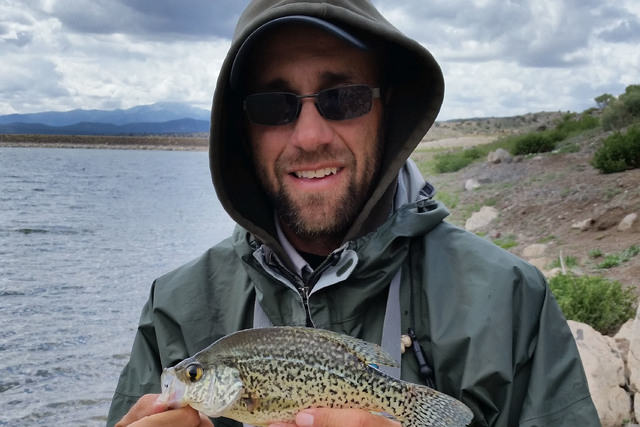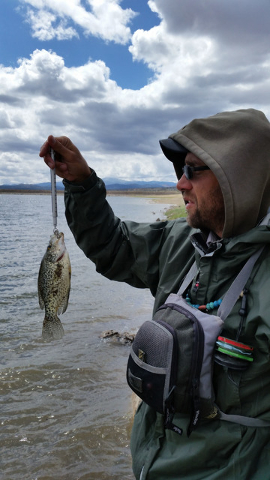Thingamabobber just the thing at Echo Canyon Reservoir
After spending the better part of a week in Lincoln County I may have learned the secret to making it rain. It would seem that all one has to do is say something like, “Think I’ll go down to the reservoir and do some fishing.”
For two days heavy yet sporadic rain pounded the countryside around Echo Canyon State Park where we were camped, but it only seemed to start whenever I said to a fellow camper, “Think I’ll go down to the reservoir and do some fishing.” Finally an observant angler who wanted to do some fishing himself suggested I could do everyone a favor by simply saying, “Think I’ll go for a walk” and leave fishing out of it.
On Friday afternoon things finally took a turn for the better. Though the sky was still cloudy, the rain subsided and I managed to find a brief window of opportunity to go for a walk along the shoreline of Echo Canyon Reservoir. There I found Mark Beckstrand, a state fisheries biologist, gathering data with his fly-rod. On nearly every cast he reeled in a silvery crappie, which he weighed, measured and then released before recording his findings in a little yellow notebook.
We exchanged pleasantries and I went to work with a small red-and-white jig a short distance away. Though far from unbearable, the wind was just strong enough to blow the jig back in my direction on every cast. So I swapped that jig for one with a little more heft, one that is silver with red flakes.
On my first cast, a plump little bass decided that jig looked good. On each of my next two casts, a scrappy crappie popped the jig and held on. “This is going to be awesome,” I thought. Then everything shut down, for me anyway. Beckstrand continued to cast and catch fish. So too did other anglers nearby. I cast my jig and caught nothing but the occasional weed fish.
Finally I set my pride aside and asked Beckstrand which fly pattern he was using. It was one he had designed with a tan-colored marabou tail and body of sparkly, lavender chenille. I didn’t have anything like it, but we talked about crappie and the nature of the reservoir. “The water is fairly shallow for about 20 yards. Then it drops off into the main channel and deeper water,” he said. “That’s where the fish hang out.”
Beckstrand also mentioned that one of his fellow biologists had found success at Sunnyside while using a Thingamabobber followed by a 3-foot leader. Suddenly something clicked. My jig was running too deep. Then I remembered there were a few Thingamabobbers in my fly bag, which just happened to be in my truck. Though my fly-rod was still in camp, perhaps I could use one with the jig.
I first learned of Thingamabobbers while fly-fishing in Montana a few years ago. They resemble a small balloon and come in a variety of bright colors. Fly-fishermen used them as a strike indicator. Within a few minutes I had a small yellow Thingamabobber tied into my rig followed by the silver jig head.
On my first cast with the new setup, the Thingamabobber hit the water and quickly disappeared. In disappointment I turned the handle on my reel. One turn, two turns, three turns, and wham! A feisty crappie popped the jig head and gave me a good fight. I tried it again with the same result. This continued until I had caught and released more than two dozen crappie and another little bass. Emphasis on little.
The Thingamabobber was just enough to keep the jig above the weeds as I reeled it in. A crappie didn’t hit on every cast, but the action was fast enough to keep anyone engaged. The key was placement of the jig in the water column and the retrieve. Success came with three to five turns of the reel followed by a pause lasting no more than a second or two. If a fish was going to take the jig, he did it as soon as I turned the reel handle again.
Later, I learned that one of the other campers went on a walk, too. He caught and released 28 largemouth bass in an hour while throwing a spinnerbait. His largest weighed more than 4 pounds, a nice fish with good girth.
Echo Canyon Reservoir is a 65-acre impoundment that is home to largemouth bass, white crappie and rainbow trout. The park is 1,800 acres and offers two campgrounds. One has 33 campsites and the other has 20 new RV sites with full hookups and shade canopies.
Freelance writer Doug Nielsen is a conservation educator for the Nevada Department of Wildlife. His “In the Outdoors” column, published Thursday in the Las Vegas Review-Journal, is not affiliated with or endorsed by the NDOW. Any opinions he states in his column are his own. He can be reached at intheoutdoorslv@gmail.com.


























